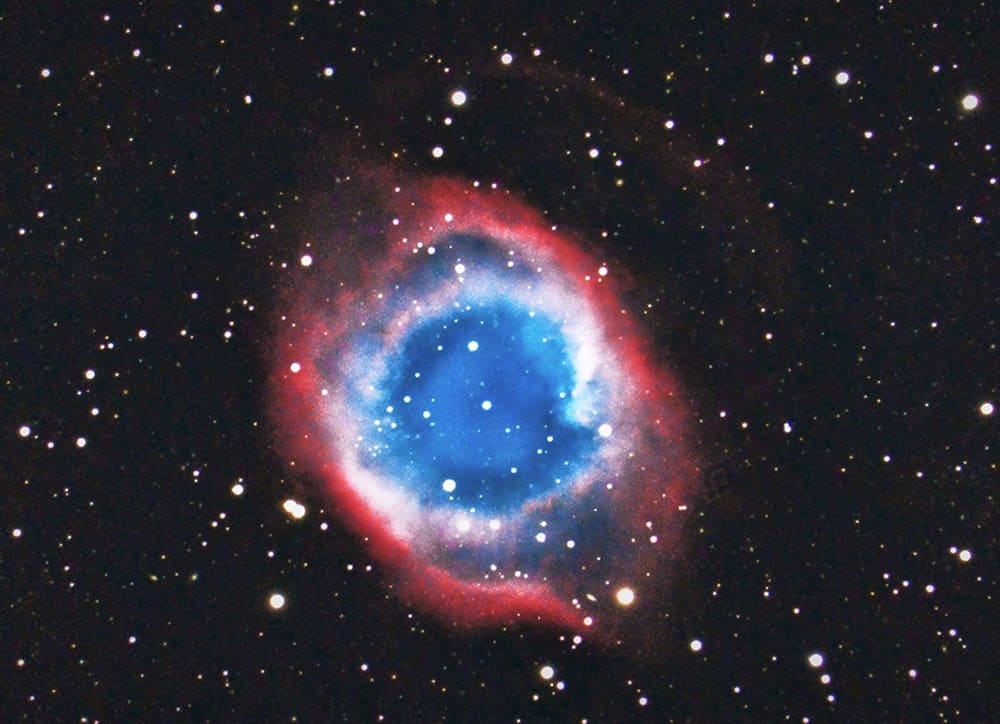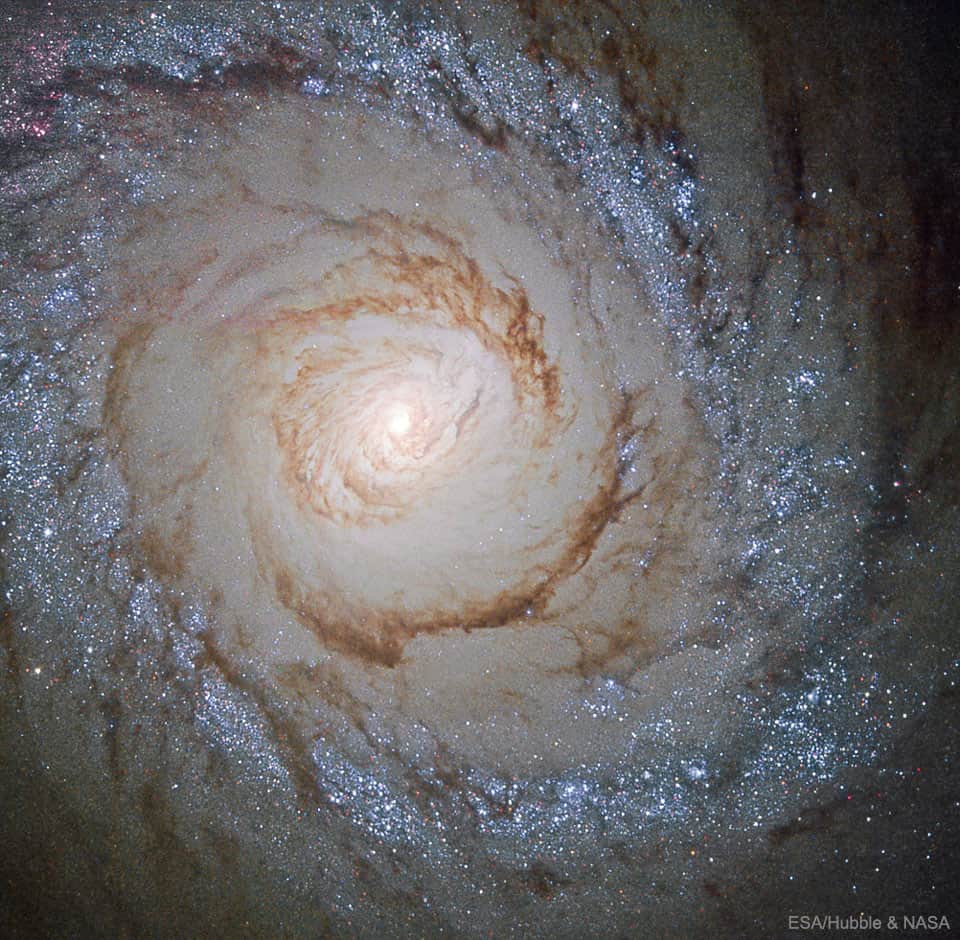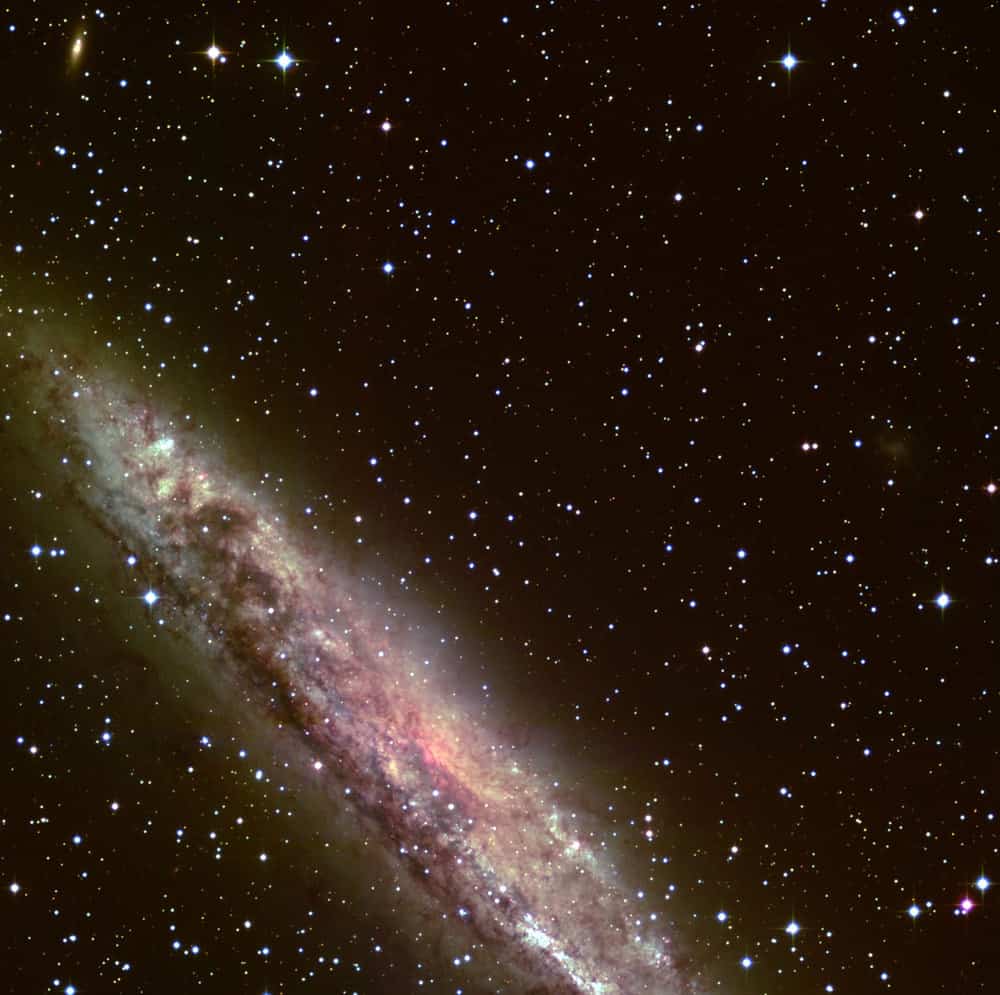Blog
The Helix Nebula (NGC 7293) is a large planetary nebula in the constellation Aquarius. The thirty-eight 10-minute exposures that the photographer combined to make this image were taken over three nights. The Helix Nebula, also known as NGC 7293, is a planetary nebula (PN) located in the constellation Aquarius. Discovered by Karl Ludwig Harding, probably before 1824, this object is one of the closest to the Earth of all the bright planetary nebulae. The distance, measured by the Gaia mission, is 655±13 light-years. It is similar in appearance to the Cat’s Eye Nebula and the Ring Nebula, whose size, age, and physical characteristics are similar to the Dumbbell Nebula, varying only in its relative proximity and the appearance from the equatorial viewing angle. The Helix Nebula has sometimes been referred to as the “Eye of God” in pop culture, as well as the “Eye of Sauron“. Distance 650 ly away.

Tal Wilkenfeld (born 2 December 1986) is an Australian singer, songwriter, bassist, and guitarist whose career began performing alongside artists including Jeff Beck, Prince, Eric Clapton, Herbie Hancock and Mick Jagger. In 2008, Wilkenfeld was voted “The Year’s Most Exciting New Player” by Bass Player magazine readers’ choice poll. In 2013, Wilkenfeld was awarded Bass Player Magazine’s “Young Gun Award” by Don Was, where she performed “Chelsea Hotel” by Leonard Cohen.
Wilkenfeld is a bandleader of her own eponymous bands in which she sings, plays bass and guitar. In her earlier work, she was backed by musicians such as Wayne Krantz and Vinnie Colaiuta. She opened for The Who on the North American part of The Who Hits 50! tour in 2016. In 2016, Wilkenfeld released a single entitled “Corner Painter” which features Blake Mills and Benmont Tench. Rolling Stone praised “Wilkenfeld is working on new music that sees her evolving from an instrumental prodigy into a formidable singer-songwriter” On March 15, 2019, Wilkenfeld released her vocal debut album Love Remains, which reached No. 1 on the Billboard Heatseeker charts on the first week of its release. Love Remains has been highly praised by the press and featured in Rolling Stone, Relix, Paste, Billboard and Forbes. Rolling Stone described Wilkenfeld’s vocal debut as “ten dense, riff-heavy tracks with brazen, introspective lyrics—prove her songwriting abilities.” Wilkenfeld has also been a guest on popular podcasts including Marc Maron and Bill Burr. Wilkenfeld was featured on the cover of Bass Player magazine’s March 2019 issue. On July 22, 2019, Wilkenfeld appeared on Jimmy Kimmel Live, performing “Killing Me” and “Corner Painter”.
more...Wynton Charles Kelly (December 2, 1931 – April 12, 1971) was an American jazz pianist and composer. He is known for his lively, blues-based playing and as one of the finest accompanists in jazz. He began playing professionally at the age of 12, and was pianist on a No. 1 R&B hit at the age of 16. His recording debut as leader occurred three years later, around the time he started to become better known as accompanist to singer Dinah Washington, and as a member of trumpeter Dizzy Gillespie‘s band. This progress was interrupted by two years in the United States Army, after which Kelly returned to Washington and Gillespie, and played with other leaders. Over the next few years, these included instrumentalists Julian “Cannonball” Adderley, John Coltrane, Roland Kirk, Wes Montgomery, and Sonny Rollins, and vocalists Betty Carter, Billie Holiday, and Abbey Lincoln.
Kelly attracted the most attention as part of Miles Davis‘ band from 1959, including an appearance on the trumpeter’s Kind of Blue, often mentioned as the best-selling jazz album ever. After leaving Davis in 1963, Kelly played with his own trio, which recorded for several labels and toured the United States and internationally. His career did not develop much further, and he had difficulty finding enough work late in his career. Kelly, who was prone to epilepsy, died in a hotel room in Canada following a seizure, aged 39.
more...Charlie Ventura (born Charles Venturo; December 2, 1916 – January 17, 1992) was a tenor saxophonist and bandleader from Philadelphia, Pennsylvania.
Ventura had his first taste of success working with Gene Krupa. In 1945 he won the Down Beat readers’ poll in the tenor saxophone category.[1][2] In the late 1940s he led several popular groups and went on to become known for his “bop for the people,” with vocalists Jackie Cain and Roy Kral.
After the early 1950s he made only a few recordings. His first was the debut album for Gene Norman’s GNP Crescendo label (GNPD No. 1) recorded live in Los Angeles. In Las Vegas, he worked with Jackie Gleason and was the featured soloist on four albums Gleason produced : Riff Jazz (1958), on which he played alto, tenor, and bass saxophones; Silk and Brass (1965); A Taste of Brass for Lovers Only (1967); and Doublin’ in Brass (1968)
Ventura died of lung cancer in Pleasantville, New Jersey at the age of 75.
more...https://www.youtube.com/watch?v=hizE1sfRWLc
more...Purchased my first Oud today, a Bavly commercial low buck model from Cario, Egypt . Now I hope I can tune and keep it tuned. Then the many maqamat to learn. Wow.



Beautiful island universe Messier 94 lies a mere 15 million light-years distant in the northern constellation of the Hunting Dogs (Canes Venatici). A popular target for Earth-based astronomers, the face-on spiral galaxy is about 30,000 light-years across, with spiral arms sweeping through the outskirts of its broad disk. But this Hubble Space Telescope field of view spans about 7,000 light-years across M94‘s central region. The featured close-up highlights the galaxy’s compact, bright nucleus, prominent inner dust lanes, and the remarkable bluish ring of young massive stars. The ring stars are all likely less than 10 million years old, indicating that M94 is a starburst galaxy that is experiencing an epoch of rapid star formation. The circular ripple of blue stars is likely a wave propagating outward, having been triggered by the gravity and rotation of a oval matter distributions. Because M94 is relatively nearby, astronomers can better explore details of its starburst ring.

John Francis Anthony “Jaco” Pastorius III (/ˈdʒɑːkoʊ pæˈstɔːriəs/, December 1, 1951 – September 21, 1987) was an American jazz bassist who was a member of Weather Report from 1976 to 1981. He worked with Pat Metheny and Joni Mitchell, and recorded albums as a solo artist and band leader. His bass playing employed funk, lyrical solos, bass chords, and innovative harmonics. As of 2017, he is the only electric bassist of seven bassists inducted into the DownBeat Jazz Hall of Fame, and has been lauded as one of the best electric bassists of all time.
Pastorius suffered from drug addiction and mental health problems throughout his professional life, and despite his widespread acclaim had problems over the latter part of his life holding down jobs due to his unreliability. In frequent financial trouble, he was often homeless throughout the mid 1980s. In 1987, he got into a fight outside of a music club in South Florida and died as result of injuries sustained in the fight. He was only 35 years old.
After his death, his work continued to influence musicians, being elected to the DownBeat Hall of Fame in 1988. He was the subject of the 2014 documentary film Jaco.
John Francis Pastorius was born December 1, 1951, in Norristown, Pennsylvania. He was the oldest of three boys born to Stephanie, his Finnishmother, and Jack Pastorius, a charismatic singer and jazz drummer who spent much of his time on the road. His family moved to Oakland Park in Fort Lauderdale when he was eight.
By 1968–1969, at the age of 17, Pastorius had begun to appreciate jazz and had saved enough money to buy an upright bass. Its deep, mellow tone appealed to him, though it strained his finances. He had difficulty maintaining the instrument, which he attributed to the humidity in Florida. When he woke one day to find it had cracked, he traded it for a 1962 Fender Jazz Bass. In his teens he played bass guitar for Wayne Cochran and the C.C. Riders.
In the early 1970s, Pastorius taught bass at the University of Miami, where he befriended jazz guitarist Pat Metheny, who was also on the faculty. With Paul Bley, Pastorius and Metheny recorded an album, later titled Jaco (Improvising Artists, 1974). Pastorius then played on Metheny’s debut album, Bright Size Life(ECM, 1976). He recorded his debut solo album, Jaco Pastorius (Epic, 1976) with Michael Brecker, Randy Brecker, Herbie Hancock, Hubert Laws, Pat Metheny, Sam & Dave, David Sanborn, and Wayne Shorter. Before recording his debut album, Pastorius attended a concert in Miami by the jazz fusion band Weather Report. After the concert, he approached keyboardist Joe Zawinul, who led the band. As was his habit, he introduced himself by saying, “I’m John Francis Pastorius III. I’m the greatest bass player in the world.”Zawinul admired his brashness and asked for a demo tape. After listening to the tape, Zawinul realized that Pastorius had considerable skill. They corresponded, and Pastorius sent Zawinul a rough mix of his solo album.
After bassist Alphonso Johnson left Weather Report, Zawinul asked Pastorius to join the band. Pastorius made his band debut on the album Black Market(Columbia, 1976), in which he shared the bass chair with Johnson. Pastorius was fully established as sole band bass player for the recording of Heavy Weather(Columbia, 1977), which contained the Grammy-nominated hit “Birdland“.
more...John Paul Densmore (born December 1, 1944) is an American musician, songwriter, author and actor. He is best known as the drummer of the rock band the Doors, and as such is a member of the Rock and Roll Hall of Fame. He appeared on every recording made by the band. Densmore is also noted for his veto of attempts by the other two Doors members, in the wake of singer Jim Morrison‘s 1971 death, to accept offers to license the rights to various Doors songs for commercial purposes, as well as his objections to their use in the 21st century of the Doors name and logo. Densmore’s lengthy court battles to gain compliance with his veto ended with total victory for him and his allies in the Morrison estate
Densmore has worked additionally in the performing arts as a dancer and actor, and written successfully as both a playwright and the author of two books on the topic of the Doors. The many honors he shares with the other Doors include a Grammy Award for lifetime achievement and a star on the Hollywood Walk of Fame.
Born in Los Angeles on December 1, 1944, Densmore grew up playing piano and later took up drums/percussion for the marching band at his school. He also played timpani in orchestra. Densmore attended Santa Monica City College and California State University, Northridge; at the latter he studied ethnic music under jazz cellist Fred Katz.
more...Louis Allen Rawls (December 1, 1933 – January 6, 2006) was an American singer, songwriter, actor, voice actor, and record producer. Rawls released more than 60 albums, sold more than 40 million records, and had numerous charting singles, most notably his song “You’ll Never Find Another Love like Mine“. He worked as a film, television, and voice actor. He was also a three-time Grammy-winner, all for Best Male R&B Vocal Performance. Rawls was born in Chicago on December 1, 1933, and raised by his grandmother in the Ida B. Wells projects on the city’s South Side. He began singing in the Greater Mount Olive Baptist Church choir at the age of seven and later sang with local groups through which he met Sam Cooke, who was nearly three years older, and Curtis Mayfield.
more...Sander L. “Sandy” Nelson (born December 1, 1938) is an American drummer. Nelson, one of the best-known rock drummers of the early 1960s, had several solo instrumental Top 40 hits and was a session drummer on many other well-known hits, and released over 30 albums. He lives in Boulder City, Nevada, and continues to experiment with music on keyboards and piano.
His first recording, with a band called the Renegades (Richard Podolor, Bruce Johnston, and Nick Venet), was “Geronimo”, written by Venet, produced by Kim Fowley, and released on the Original Sound Records label. Although it flopped on the national charts, it charted in some of the Mid West markets. The song, along with “Charge”, is part of the soundtrack of 1959 film Ghost of Dragstrip Hollowreleased by American International Pictures.
Nelson attended high school with Jan Berry, Dean Torrence (who became Jan and Dean), and Kim Fowley. After gaining respect as a session drummer, he played on such songs as “To Know Him Is To Love Him” (Phil Spector‘s Teddy Bears, 1958), “Alley-Oop” (The Hollywood Argyles, 1960), and “A Thousand Stars” (Kathy Young and the Innocents, 1960).
more...Ike Isaacs (December 1, 1919, Rangoon, Burma – January 11, 1996, Sydney, Australia) was a jazz guitarist from Rangoon, Burma, best known for his work with violinist Stéphane Grappelli.
Isaacs was self taught on guitar. He started playing professionally in college while pursuing a degree in chemistry. In 1946 he moved to England, where he became a member of the BBC Show Band. During the 1960s and ’70s, he was a member of the Hot Club of London, led by guitarist Diz Disley, which often collaborated with Stéphane Grappelli. He was a member of the band Velvet with Digby Fairweather, Len Skeat, and Denny Wright. In the 1980s, he moved to Australia and taught at the Sydney School of Guitar.
more...This image is an enlargement at full resolution of a smaller region (about 1/7 by area) of a sky field around the spiral galaxy NGC 4945 . It is assembled from five 15-minute R(ed)-narrowband (shown in red), four 5-minute B(lue)-band (shown in green), and five 1000-second U(ltraviolet)-band (shown in blue) exposures, obtained in January 1999 during the Science Verification phase with the Wide-Field-Imager (WFI) at the MPG/ESO 2.2-m telescope at La Silla. At the recession velocity of NGC 4945, the red filter, centred at 665 nm with an FWHM (full width at half maximum) of only 1.2 nm, does not include the H-alpha emission line of interstellar hydrogen in this galaxy. The original resolution of about 1 arcsec corresponds to roughly 62 light-years at the distance of NGC 4945 (13 million light-years). In addition to NGC 4945 itself, some much more distant galaxies can be recognized as faint, slightly red light patches in the field. The vast majority of the point-like sources are stars in the Milky Way. However, a fair number of those near NGC 4945 are globular clusters belonging to this galaxy. Each frame records 8184 x 8196 = 67,076,064 pixels, and thus the total number of data points (pixels) of the 14 CCD frames used to make this photo is almost 10 9. Their collective information content corresponds to more than 70 x 10 9 photons (not counting those from the Earth’s upper atmosphere that were recorded simultaneously). It covers 2997 x 2998 pixels and measures about 12 x 12 arcmin 2 in the sky. Note the many background galaxies in the field.

Johnny Shuggie Otis (born Johnny Alexander Veliotes, Jr.; November 30, 1953) is an American singer-songwriter, recording artist, and multi-instrumentalist.
Otis’s composition “Strawberry Letter 23” (as recorded by The Brothers Johnson) topped the Billboard R&B chart and reached #5 of the Billboard Hot 100 chart in 1977. He also achieved commercial success with his 1974 single “Inspiration Information” (from the album of the same title), reaching #56 on the R&B chart.
Born in Los Angeles, California, Otis is the son of rhythm and blues pioneer, musician, bandleader, and impresario Johnny Otis, who was of Greekdescent, and his wife Phyllis Walker, who was of African American and Filipino descent. The name “Shuggie” (short for “sugar,” according to his mother) was coined by Phyllis when he was a newborn. Otis began playing guitar when he was two years old and performing professionally with his father’s band at the age of eleven, often disguising himself with dark glasses and a false mustache so that he could play with his father’s band in after-hours nightclubs.
more...Jack Sheldon (born November 30, 1931) is an American bebop and West Coast jazz trumpeter, singer, and actor. He is a trumpet player and was the music director on The Merv Griffin Show, as well as the voice heard on several episodes of the educational music television series Schoolhouse Rock! Sheldon was born in Jacksonville, Florida, United States. He originally became known through his participation in the West Coast jazz movement of the 1950s, performing and recording with such figures as Art Pepper, Gerry Mulligan, and Curtis Counce. Sheldon played the trumpet, sang, and performed on The Merv Griffin Show. He was Griffin’s sidekick for many years. Prior to joining Griffin’s show, he served as bandleader for the short-lived The Las Vegas Show.
https://www.youtube.com/watch?v=m4ZKqwvuRLs
Walter Brown “Brownie” McGhee (November 30, 1915 – February 16, 1996) was an African-American folk music and Piedmont blues singer and guitarist, best known for his collaboration with the harmonica player Sonny Terry. McGhee was born in Knoxville, Tennessee, and grew up in Kingsport, Tennessee. At about the age of four he contracted polio, which incapacitated his right leg. His brother Granville “Sticks”(or “Stick”) McGhee, who also later became a musician and composed the famous song “Drinkin’ Wine Spo-Dee-o-Dee,” was nicknamed for pushing young Brownie around in a cart. Their father, George McGhee, was a factory worker, known around University Avenue for playing guitar and singing. Brownie’s uncle made him a guitar from a tin marshmallow box and a piece of board.
McGhee spent much of his youth immersed in music, singing with a local harmony group, the Golden Voices Gospel Quartet, and teaching himself to play guitar. He also played the five-string banjo and ukulele and studied piano. Surgery funded by the March of Dimes enabled McGhee to walk.
At age 22, McGhee became a traveling musician, working in the Rabbit Foot Minstrels and befriending Blind Boy Fuller, whose guitar playing influenced him greatly. After Fuller’s death in 1941, J. B. Long of Columbia Records promoted McGhee as “Blind Boy Fuller No. 2.” By that time, McGhee was recording for Columbia’s subsidiary Okeh Records in Chicago, but his real success came after he moved to New York in 1942, when he teamed up with Sonny Terry, whom he had known since 1939, when Terry was Fuller’s harmonica player. The pairing was an overnight success. They recorded and toured together until around 1980. As a duo, Terry and McGhee did most of their work from 1958 until 1980, spending 11 months of each year touring and recording dozens of albums.
more...More Posts
- Daily Roots with Al Campbell
- Surviving the Pandemic and Realizing Racial Justice
- The Cosmos with the Great Conjunction of Jupiter and Saturn
- Billy Bragg
- Larry Willis
- Cousin Joe
- World Music with Yamila Ibarra
- Daily Roots with Carl Campbell
- Surviving the Pandemic and Realizing Racial Justice
- The Cosmos with M63
- Kermit Ruffins
- Lenny White
- Bobby Timmons
- Professor Longhair
- Édith Piaf
- World Music with Makgona Ngwao
- Daily Roots with Roots Radics
- Surviving the Pandemic and Realizing Racial Justice
- The Cosmos with OCL 535
- Keith Richards